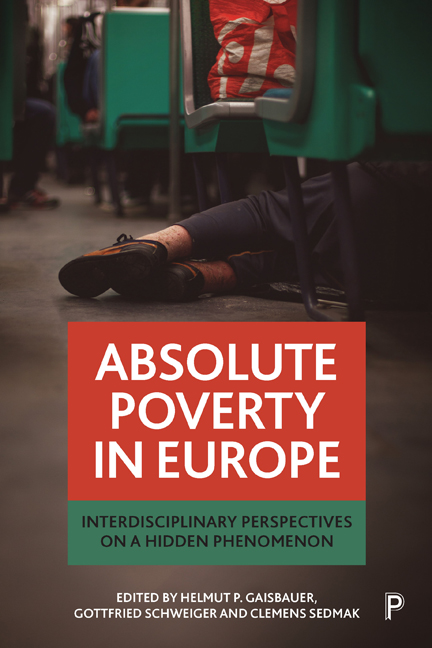Book contents
- Frontmatter
- Contents
- List of figures and tables
- Notes on contributors
- 1 Absolute poverty in Europe: introduction
- Part One Conceptual and methodological challenges
- Part Two Key issues for the absolute poor
- Part Three Policy responses to absolute poverty in Europe
- Part Four Ethical perspectives on absolute poverty in Europe
- Conclusion responding to the dark reality of absolute poverty in European welfare states
- Index
12 - Absolute poverty and social protection in the EU: a cross-national comparison
Published online by Cambridge University Press: 27 April 2022
- Frontmatter
- Contents
- List of figures and tables
- Notes on contributors
- 1 Absolute poverty in Europe: introduction
- Part One Conceptual and methodological challenges
- Part Two Key issues for the absolute poor
- Part Three Policy responses to absolute poverty in Europe
- Part Four Ethical perspectives on absolute poverty in Europe
- Conclusion responding to the dark reality of absolute poverty in European welfare states
- Index
Summary
Introduction
Despite the EU's overall affluence, absolute poverty in EU countries is a real problem, affecting not only weak groups at the margins of society, such as homeless people, undocumented migrants and Roma (the so-called ‘invisible poor’), but also quite a few registered individuals and households. This often happens in a manner less noticeable to public opinion, even if it affects the ‘next door neighbour’ who is facing some sort of absolute poverty.
Given that absolute poverty is meant to be a lack of basic resources necessary for subsistence and reproduction (for example, adequate housing, clean water, proper medication), this condition has mostly been associated with less developed countries. Therefore, the $1-a-day indicator has been chosen to operationalise absolute poverty on a world scale, although this indicator suffers from serious methodological biases and measurement errors.
According to Chossudovsky (1999), this indicator is purely an ‘arithmetical game masking the real nature and magnitude of absolute poverty worldwide. By arbitrarily setting a poverty threshold at $1 a day per capita and then distinguishing between the poor and non-poor in each population (without even measuring), it conveniently undervalues poverty without the need to collect country-level data. Since 2008, a new poverty threshold has been set at $1.25 a day; however, the intrinsic fallacy of this indicator remains.
More importantly, though, the social implications of this methodological choice are profound insofar as this definition is not value- and ideology-free either and, in consequence, it greatly affects the public perceptions and the policy priorities for poverty reduction. Thus, absolute poverty has often been regarded as less of an issue in more developed national contexts. However, the 2007–2008 world economic crisis and the ensuing recession and austerity have worsened poverty outcomes in the EU. This development has attracted scientific and political attention towards aspects of absolute poverty that have systematically been overlooked in the past (for example, see Bradshaw and Mayhew, 2011).
The aim of this chapter is to shed light on absolute poverty trends and patterns in the EU from an empirical point of view by utilising EU-SILC indicators and data. Operationalising absolute poverty as extreme deprivation offers the analytical advantage of capturing the structural, relational, multidimensional and persistent nature of poverty.
- Type
- Chapter
- Information
- Absolute Poverty in EuropeInterdisciplinary Perspectives on a Hidden Phenomenon, pp. 249 - 266Publisher: Bristol University PressPrint publication year: 2019



